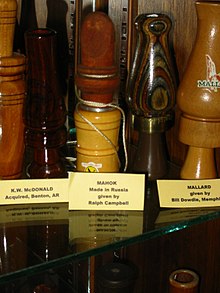Stuttgart (Arkansas)
| Stuttgart | |
|---|---|
| Nickname : Rice and Duck Capital of the World | |
 The main street |
|
| Location in county and Arkansas | |
| Basic data | |
| Foundation : | 1878 |
| State : | United States |
| State : | Arkansas |
| County : | Arkansas County |
| Coordinates : | 34 ° 30 ′ N , 91 ° 33 ′ W |
| Time zone : | Central ( UTC − 6 / −5 ) |
| Residents : | 9,400 (as of 2004) |
| Population density : | 591.2 inhabitants per km 2 |
| Area : | 15.9 km 2 (approx. 6 mi 2 ) |
| Height : | 64 m |
| Postal code : | 72160 |
| Area code : | +1 870 |
| FIPS : | 05-67490 |
| GNIS ID : | 0058703 |
| Website : | www.stuttgartarkansas.com |
Stuttgart is a city in the US state of Arkansas and together with DeWitt County Seat of Arkansas County .
geography
The city is located about 70 km southeast of Little Rock on US Highway 79 . The airport Stuttgart Municipal Airport is located about 10 km north. According to the United States Census Bureau , the city has an area of 16.0 km², excluding land.
history
This Stuttgart was founded in 1878 by Adam Bürkle from Plattenhardt . Bürkle, who emigrated to America in 1852 , first worked as a pastor in Lansing (Michigan). In October 1878 he and 65 people founded a settlement on Gum Pond, a pond with rubber trees on its banks. When he set up a post office in his house in 1880, the place had to be given a name. In memory of his old home, he gave it the name " Stuttgart ".
The railway was built in 1882. But the route did not pass the post office; therefore the train did not stop at Bürkel's settlement. Bürkle, however, owned land on the railway line. So he built a hut near the rails and nailed a sign with the name “Stuttgart” on it. This is where the new city center developed, about two miles southeast of his home.
Stuttgart was made a city in 1884. Significant efforts were made to boost the economy in the early 20th century. Woodworking workshops in particular emerged. In 1902 a farmer tested rice cultivation. In 1904 the first commercial rice field was created, measuring 70 acres. Hundreds of families from the north and the midwest came to Stuttgart and bought land in order to benefit from the now flourishing rice cultivation. A rice mill was built in 1907 and today the city is home to Riceland Foods , which is responsible for a third of the US rice harvest. After the Second World War, soybeans were also grown around Stuttgart.
Stuttgart is known as the world capital of rice and duck hunting ( Rice and Duck Capital of the World ). Duck hunting championships are held annually. Many stores specialize in the sale or manufacture of hunting clothing and equipment (especially decoy whistles).
| Population development | |||
|---|---|---|---|
| Census | Residents | ± in% | |
| 1890 | 1165 | - | |
| 1900 | 1258 | 8th % | |
| 1910 | 2740 | 117.8% | |
| 1920 | 4522 | 65% | |
| 1930 | 4927 | 9% | |
| 1940 | 5628 | 14.2% | |
| 1950 | 7276 | 29.3% | |
| 1960 | 9661 | 32.8% | |
| 1970 | 10,477 | 8.4% | |
| 1980 | 10,941 | 4.4% | |
| 1990 | 10,420 | -4.8% | |
| 2000 | 9745 | -6.5% | |
A local museum of local history guides interested tourists through the entire history of Stuttgart. The museum is run on a voluntary basis. Admission is free.
Others
The film Rosalie Goes Shopping by Percy Adlon (1988, USA) plays in Stuttgart / Arkansas . The Bavarian Rosalie ( Marianne Sägebrecht ) lives there with her family. Rosalie is an obedient consumer of the lure of advertising. That brings them more and more on the wrong track. She goes on a shopping spree in Stuttgart with fake credit cards and checks.
Individual evidence
- ↑ Glen Sparks: Ducks and Rice Are Staples in Stuttgart. In: The Regional Economist. Federal Reserve Bank of St. Louis, October 2005, archived from the original on September 30, 2007 ; accessed on August 2, 2009 .
- ^ Extract from the Encyclopedia of Arkansas . Retrieved February 13, 2011.
Web links
- Arkansas-Stuttgart homepage
- Stuttgart (Arkansas County) in the Encyclopedia of Arkansas

